Abstract
The accelerated deterioration of water quality in the city of Tarija, Bolivia, has caused several water sources in the Municipality of Tarija to be discontinued due to the presence of toxic contaminants. The current water purification systems that are used in Tarija do not guarantee the elimination of heavy metals; in addition, political and social interest conflicts are a serious problem in the execution of projects and new public investment alternatives, with these being the main problems found in the sector. Reverse osmosis (RO) water purification technologies are one of the most effective contemporary alternatives for the elimination of contaminants in water, such as heavy metals; however, their application and implementation in countries with little or no experience in this type of technology require acceptance and knowledge on behalf of the interested parties. Political and social conflicts between interested parties generate scenarios that affect hydrological planning. Analysis of the actors in the urban and municipal sphere of the city of Tarija, Bolivia, provides a case study for adequate water governance and enabled us to come to a consensus for the implementation of RO. The results show 23 fundamental actors in water management in the Municipality of Tarija, with local actors being those with the greatest influence and power in decision-making. Our analysis of social networks showed an important polarization in the power of decision makers, with municipalities and legislative entities being those that decide on public investments. The interested parties showed considerable interest in the application of RO as a technology that can provide definitive, short-term solutions to the problems of water stress and the water crisis in the Municipality of Tarija and its application in small towns with a high level of social and environmental vulnerability.
1. Introduction
The increase in contamination from different anthropic activities has decreased the quality of drinking water in different parts of the world [1,2,3]. Bolivia has experienced significant population growth and unorganized development, which has led to a growing and sustained process of water contamination in various areas of the country. Similarly, several water sources in the Municipality of Tarija, Bolivia, present toxic contaminants, such as heavy metals, which represent a risk to the public health of the population [4,5,6,7,8].
The risk posed by toxic metal contaminants to public health is a current challenge for the development and application of different advanced water treatments. Metals such as copper, zinc, manganese, and iron play important roles in the biochemical processes of the human body. However, excessive exposure to these metal ions can cause dangerous impacts. Other heavy metals, such as lead, are toxic, even at trace levels, because they can bioaccumulate in major systems of the human body [9,10].
Researchers such as Razzak, S. et al., and Borji, H. et al. [11,12] indicate that contamination by toxic pollutants and its implications for human health and the environment have increased research efforts to develop effective and sustainable remediation technologies. They argue that methods based on adsorption, coagulation, flocculation, and chemical precipitation technologies are examples of rapid but less efficient and effective conventional methods in the removal of heavy metals, and treatments with membranes or nanotechnologies offer more efficiency and effectiveness in water treatment. Reverse osmosis water purification is becoming more affordable. Additionally, coupling renewable energy with desalination technology is a smart and sustainable alternative, and plays a fundamental role in promoting regional cooperation [13].
Sahin, O. et al. [14] and Cervantes-Rendón, E. et al. [14,15] point out that management models for water supply planners seek to proactively plan, account for, and finance portfolios of water supply infrastructure. Analysis of interested parties is a fundamental alternative for implementing new technologies, such as RO.
History in Bolivia has shown that water governance is a fundamental issue in the management, sustainability, and preservation of water resources. Political, social, and cultural differences hinder the implementation of public policies and the execution of investment projects. Recent investigations carried out in Tarija and La Paz, Bolivia [16], demonstrate the effectiveness of the removal of toxic contaminants present in drinking water through reverse osmosis. The results show that reverse osmosis can be implemented at low operating pressures, demonstrating significant sustainability in terms of energy and economic efficiency [16,17,18].
Water management in hydrological basins requires the participation and cooperation of different actors. The sustainable management of natural resources in an increasingly populous world is challenging, even more so when information asymmetries and conflicts of interest exacerbate tensions between stakeholders. The interactions in a basin are guided by the interest and sphere of influence of the actors who have promoted the implementation of a collaborative water governance framework [19,20,21,22].
The management of water and energy resources will be more efficient when “active water citizens” increase environmental awareness by promoting monitoring measures and data collection, which significantly increases public motivation and environmental awareness for the efficient use of natural resources. Economic growth accompanied by global climate change exerts more significant pressure on conventional sources of drinking water, and it is necessary and urgent to create cooperative, sustained, and sustainable projects capable of supplying safe water with fewer risks, lower costs, and better technologies [13,14,15,16,17,18,19,20,21,22,23,24].
The management of water resources is a social and political challenge, for which administrators face a series of natural and anthropic problems, such as the hydrological variability in basins, climate change projections, and the constant degradation and contamination of water sources. These factors interfere in the management of water in urban areas, with the most critical factors being the increase in contamination and variation in flows [25,26,27,28,29,30,31]. The implementation of water management strategies in urban areas is problematic due to the lack of adequate communication tools, the low active participation of citizens, and the need to incorporate new knowledge and information in decision-making [32,33,34,35].
Lintsen [36] affirms that, traditionally, the field of water management was dominated by professionals from institutions, generating closed and highly connected communication networks between authorities. With the incorporation of interested parties, citizens are more aware of decisions, which can lead to new conflicts in water management [35,37]. For his part, Van Buuren [38] indicates that experts and interested parties have different perspectives and needs, suggesting the need to carry out negotiation processes for adequate interventions [39,40]. He points out that water policies are hampered by the members of an affected community having little participation in and understanding of problems, and that water policy making requires the dedicated participation of all stakeholders; however, difficulties remain for the community sector.
Political, economic, and administrative systems of a basin are a fundamental part of water governance, which is why it is necessary to formulate policies and alliances between different actors to adequately promote sustainable development and reduce institutional dispersion, lack of coordination, and competition between stakeholders [41,42,43]. In this context, stakeholders are defined as “any group or individual who can affect or be affected by the achievement of project objectives”. It is the people that matter in a system, and analyzing their power is a tool that helps us to understand how they affect policies and institutions [44,45,46].
Reed et al. [47] explains the need to carry out a stakeholder analysis for the participatory management of natural resources and proposes a study typology consisting of methods to identify, differentiate, classify, and investigate the relationships between stakeholders.
There are several methods for stakeholder analysis; Yang et al., and Trawick [48,49] use levels of interest and influence in water resource management. They classify them into four categories: key players, context makers, themes, and crowds. In turn, Lupo and the Overseas Development Administration [ODA] [50,51] distinguish stakeholders as primary or those who are affected, either positively as direct beneficiaries or negatively as those who are involuntarily resettled; secondary stakeholders are intermediaries in the process of the delivery or management of the aid.
Clarkson [52] categorizes the primary stakeholders as those that are essential for the survival and well-being of an organization, and the secondary stakeholders as those that interact with the organization but are not necessary for its survival or well-being. Grimble and Wellard [53] also distinguish two categories: the active stakeholders, which influence a decision or action, and the passive stakeholders, which are the parties involved in said action or decision.
Mitchell et al. [54] consider stakeholder attributes such as power (to influence the organization), legitimacy (of a relationship between stakeholders and the organization), and urgency (of a claim), and offer three qualitative classes: a class of low relevance that has only one of the attributes and is called a latent actor; a moderately special type with two attributes and calls them future stakeholders; and the most outstanding class that has them all.
For its part, the Water Framework Directive (Directive 2000/60/EC, WFD) of the European Commission [55] adopted this new idea of stakeholder participation (instead of simple public participation) and states that stakeholder participation is a crucial element for the successful implementation of this innovative new regime for sustainable water management.
Bacchar et al. [56] developed a model for building scenarios with stakeholders [Approach for Building Adaptation Scenarios with Stakeholders, ABASS]. It identifies adaptation policies and corresponding natural resource management scenarios and combines different existing participatory methods. It is organized in three steps. In step 1, experts identify local problems on a map. In step 2, the experts identify stakeholders. Step 3 leads to scenario building with stakeholders. The selection of stakeholders is a critical step to ensure the viability, legitimacy, and success of the participatory process [57,58].
León and Hirschia [57,59] recommend the use of a method of interconnectivity between collective actors in social planning processes, such as social network analysis [ARS], which enables analysis of the flow of communication between interested parties. In this way, a qualitative study, such as mapping, is complemented by a quantitative study such as ARS.
The Bolivian State, in its Political Constitution of the State, articles 16, 20, and 373, establishes that water is a fundamental right for life; the State is responsible for protecting and guaranteeing the priority use of water for life, and must manage, regulate, protect, and plan the equitable and sustainable use of water resources, with social participation. The Ministry of Environment and Water is the reference institution for water planning and management [60].
At the subnational level, the Framework Law of Autonomies and Decentralization “Andrés Ibáñez”, Law 031 of 19 July 2010, determines the allocation of powers in terms of basins and the comprehensive management of water resources to the governorates and municipalities through the Departmental Water Plans, which seek to articulate the different autonomous levels with the central state level [61]. Currently, the urban area of the Guadalquivir basin is in a critical state of contamination of its main water supply sources due to human activities. Various heavy metals have been identified in the water, and the current purification systems do not guarantee an adequate process for the removal of these contaminants. Reverse osmosis is considered to be a sustainable alternative to providing safe water to the urban area of Tarija. According to the principle of Walshot et al. [13], identifying challenges in the adoption of drinking water technologies can help countries address concerns about water safety.
This study shows the analysis and identification of the main actors and stakeholders in the management and administration of water in the municipality of Tarija, and how their classification and inter-relationship can influence the implementation of public investment projects focused on water resources, mainly the implementation of new technologies such as RO for water purification and its impact on vulnerable areas, such as towns located in the Cirminuelas [62,63].
Objectives and the Study’s Novelties
This study aimed to identify, classify, and characterize the main actors in water management and determine the relationship between them and the interest and the influence they have in water management in the municipality of Tarija, Bolivia, and how the relationship between them can influence the decision to implement RO in the water treatment process.
The identification of stakeholders in the management of water in the municipality of Tarija, and determining the power of decision-making and influence in the management of water projects, visualizes the difficulties in the implementation of RO.
The analysis of stakeholders in the management of water in Tarija leads to the analysis of social networks to identify the main key actors in the management.
2. Methodology
A case study was selected around the water problem that responds to the current social situation in Tarija, Bolivia. A case study approach is more flexible and participatory, enabling regional development projects to be proposed and prioritized with stakeholder validation and participation [57,64]. Figure 1 shows the steps and techniques used in the development of this study.
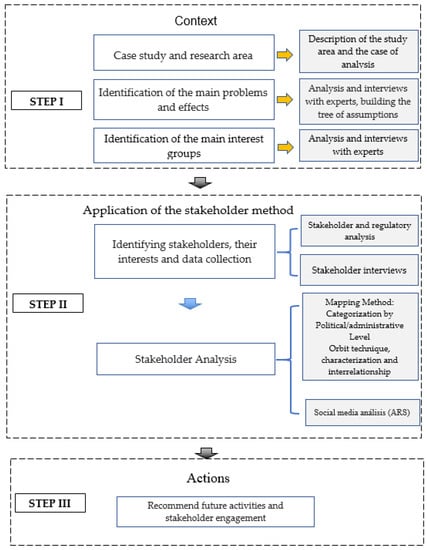
Figure 1.
Steps and techniques applied in the development.
The scheme in Figure 1 shows that, in step 1, the study area is defined and the main problems found in the area are identified, in addition to identification of the main groups and institutions of interest. Step 2 enables the specific identification of each stakeholder, the definition and identification of the analysis data, and the preparation of maps and tables characterizing and classifying the stakeholders based on interest, influence, and power in decision-making in water projects. In addition, in step 2, the analysis of social networks is carried out in order to visualize and identify the main actors of power and the relationships with other stakeholders that influence decisions. Finally, in step 3, the main conclusions, recommendations, and future activities are defined.
2.1. Context of the Case Study
The study was carried out for the urban area of the municipality of Tarija, located in the Guadalquivir River Basin, in the Department of Tarija, in the Plurinational State of Bolivia. It contains 11 rural and urban municipalities; the municipality of Cercado is the reference departmental capital. The basin has an approximate area of 1750 km2 and a population of almost 400,000 inhabitants.
The urban area of the municipality of Tarija covers 11,846 hectares and is divided into 13 districts and 86 neighborhoods. Each neighborhood has a Neighborhood Council that forms the Federation of Neighborhood Councils of Tarija (FEJUVE). The main objective of this body is to promote neighborhood development projects and supervise their implementation.
In recent decades, the municipality of the city of Tarija has experienced solid economic growth, which has brought with it a process of permanent and growing contamination of the primary sources of drinking water, paralyzing many of them due to the presence of toxic contaminants. The lack of communication channels between technical and the social aspects means that the projects cannot be carried out, and therefore, a solution to the water contamination cannot be found.
Most of the territory of the municipality of Tarija is predominantly rural, with significant development of agricultural and livestock activities. According to government data concerning the Autonomous Municipality of Tarija, there are high levels of poverty in rural areas of Tarija, concentrated in the 17th district, Cirminuelas; the 20th district, San Agustin and Canchones; and the 21st district, Junacas, with a poverty index between 72% and 90% in terms of unsatisfied basic needs (UBN) [64]. Figure 2 shows the location of the study area.

Figure 2.
Location of the study area, own elaboration.
2.2. Approaches, Methods Used, and Data Collection
Several techniques complemented the stakeholder analysis: in the first instance, mapping analysis was performed; subsequently, social network analysis (ARS) was undertaken.
Personal interviews were conducted with the key actors and authorities. All expressed an interest in actively participating in consensus processes and coordinated decision-making. The result again showed the political differences between the different actors. There was a rapprochement between the neighborhood councils and the Municipality. The private entities did not exhibit political differences, but they expressed the need to communicate more about the scope of the projects.
To understand the relationship and information between the different stakeholders, questions pertained to the use of project resources and information. The following questions were asked of each stakeholders:
What is the interest in participating in local development decisions?
- With whom do you generally have an institutional relationship in the planning of water-related projects?
- To whom do you think it is important to extend the institutional relationship in the planning of projects and resources related to water?
- Is there any knowledge about water purification through RO?
For each answer, it is necessary to give a score: if the relationship is zero or does not exist, 0; if it is minor, 1; and if it is considerable, 2. The results were used to build a social network.
2.3. Identification of Interested Parties
The first step in the stakeholder analysis was to identify the groups and actors involved in the sector and the problems arising from the conflict scenarios. The methods proposed by Baccar et al. [56] were used to identify the issues and strategies. The approaches developed by Leach [65] and Hearne and Torpen [20] were used to identify interest groups.
2.3.1. Map-Based Analysis
The mappings were based on classifying and characterizing stakeholders according to specific categories of power, interest, influence, legitimacy, and urgency. Among the best known mapping techniques used in this study were those developed by Aggens [66], Grimble and Wellard [53], Lupo [50], Trawick [49], and Yang et al. [49] to perform classification according to levels of interest, power, and influence. Grimble and Wellard [53] and Biggs and Matsaert proposed methods to analyze the influence between stakeholders; Chevalier and Buckles [67,68] measured the degree of affectation.
2.3.2. ABASS Approach to Identifying Problems and Scenarios
Baccar et al. [56] identified problems and conflict scenarios. The first two steps involve local experts in different fields and the understanding of a large amount of information. The third step involves local actors, mainly policy makers or those who influence public development policies.
2.3.3. Identification of Interest Groups
Based on the criteria of Leach [65] and Hearne and Torpen [20], preliminary interviews can be conducted to identify key stakeholders in water management and decision-making power.
2.3.4. Identification and Categorization of Stakeholders
Internal orbits, with local and departmental stakeholders, correspond to groups with a high degree of interest and influence. External stakeholders, such as national and international actors, can be considered as groups with little interest and impact.
Likewise, the interested parties were classified and categorized in matrix diagrams, as proposed by Grimble and Wellard and exposed by Lupo [50,53], in which the level of importance and influence is considered. Figure 3 shows the categorization of stakeholders from an orbit system; Figure 4 is the matrix system.
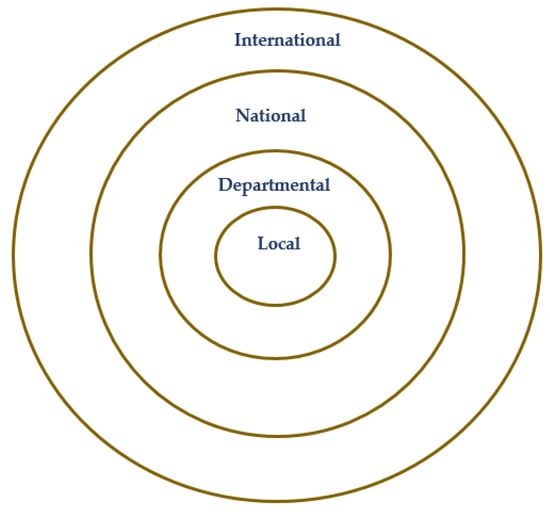
Figure 3.
Orbit system to identify stakeholders and degree of participation.
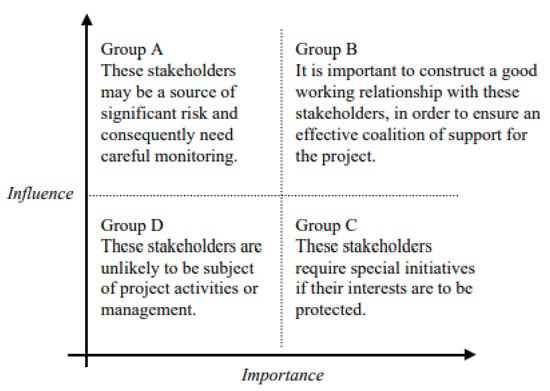
Figure 4.
Stakeholder classification matrix according to influence and active importance [54].
For his part, Trawick [49] points out that the stakeholder analysis method is based on the level of interest and influence in the management of water resources. Figure 5 shows how stakeholders can be classified into four categories.
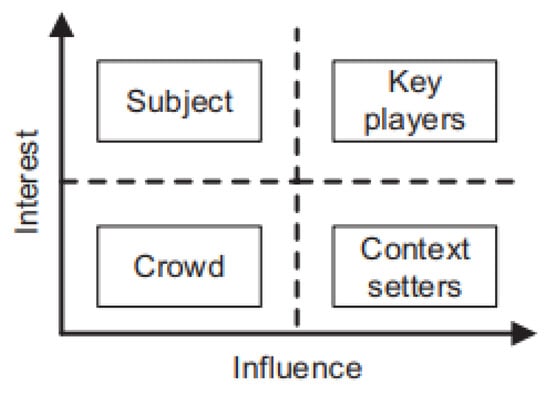
Figure 5.
Stakeholder analysis matrix according to influence and interest [49].
The orbital scheme in Figure 3 categorizes the actors in four levels of participation: local in the central part; departmental and national in the second and third parts, respectively; and international in the fourth. The matrices in Figure 4 and Figure 5 enable classification the point of view of the importance and the influence that each actor has.
In order to avoid the increased risk of inadvertently omitting some actors, with the consequence that not all relevant actors of the phenomenon can be identified, Clarke and Clegg [69] recommend taking into account geographical, demographic, and political criteria, including nationality, age, etc.
Lupo and Mitchell et al. [50,54] classify stakeholders as latent, expectant, and definitive actors, obtained by assigning attributes. Power is defined as the past and present influence of stakeholders around the project at the national, departmental, or local level, be it in the design or implementation phase of the project. Legitimacy is when the claims, demands, procedures, or interests of the parties concerned with the project are adequate, appropriate, and eligible within the social and political system. Urgency is the extent to which a stakeholder is active and can demonstrate its efforts, management, and requests with the utmost urgency and immediate attention in the implementing of the project. Proximity to the intervention area is a better way to find information about the intervention project or program [70].
A scale of values is proposed for each interested party based on the attributes identified by the evaluated party. One is the lowest and five is the highest of the attributed scales [71].
The scores assigned to each stakeholder were objective, based primarily on the power, interest, and influence they may have in the project’s implementation.
Stakeholders whose average score for each attribute was greater than or equal to 3 were considered high, whereas those whose average score was less than 3 were considered low. Stakeholders with all attributes scoring 3 or higher were classified as definitive stakeholders, whereas those with only one attribute or none were classified as latent stakeholders. However, all stakeholders in a middle position, with scores between 2 and 3, were classified as expectant [50].
Lupo [72] proposed that the appropriate level of involvement of ultimate stakeholders is participation, and categorized these as collaborating actors because they have a lot of power, legitimacy, and urgency and are close to the catchment area; in other words, they are the most important stakeholders and should be involved at the highest level. On the other hand, the appropriate degree of intervention of expectant stakeholders is the second stage of participation, defined as thought actors; these interested parties must be consulted to obtain useful information and opinions. Finally, the appropriate level of involvement of latent stakeholders is the third level of participation, and classified as knowledge actors; in other words, they must be kept informed.
2.3.5. Relationship between Stakeholders and Adaptation to Scenarios
The relationships between of interested parties demonstrate the degree of interaction generated between actors. The interconnections or inter-relationships generate scenarios of power and influence and enable the visualization of possible scenarios of conflict or opportunities for consensus. To identify these inter-relationships, it is necessary to ascertain the criteria of each stakeholder and the affinity or conflict with other actors or groups. Figure 4 describes how to relate and link stakeholders [50,51,53,67,73].
2.3.6. Degree of Affectation of the Interested Parties by the Problems
It is important to classify stakeholders according to the degree of affectation to which the different stakeholders are exposed to the identified problems and actions. Chevalier and Buckles [68] proposed a rainbow diagram to classify stakeholders according to the degree of affectation; Yang et al. [48] configured a matrix in which the influence of the different actors relates to the degree of probability in which they can be affected. Figure 6 illustrates the rainbow scheme.
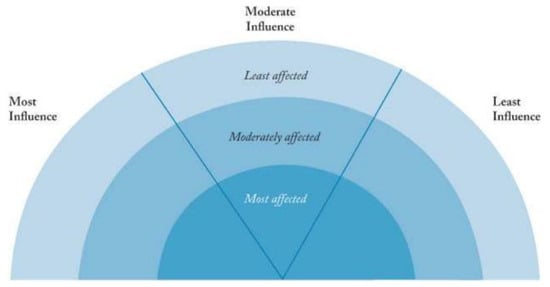
Figure 6.
Rainbow diagram to classify stakeholders by level of impact [69].
Decisions about policies or projects in the sector can generate benefits and adverse impacts for key stakeholders. The impacts can affect stakeholders who are indirectly involved in a project. Figure 6 determines the degree of impact that each stakeholder may have if the project is implemented.
2.4. Social Network Analysis
Prell et al. [74], Borgatti et al. [75], and León [57] explain very clearly that analysis of social networks requires qualitative analysis to be performed concordantly with quantitative analysis; in addition, it is a method that studies the “relationships” that exist between actors to analyze their position within the network and to draw conclusions that are useful for the objectives of the study. There are several tools for the construction of networks. UCINET© [57] is a program that enables adequate construction of networks based on the levels of communication between interested parties.
3. Results and Discussion
The results of the stakeholder analysis are detailed. The identification and classification of the stakeholders, and the study of the social networks indicating the behavior of each stakeholder, are shown.
3.1. Identification of Potential Problems and Diversity of Effects
The main problems that affect the quality and quantity of water in the study area were identified by experts in the water sector and academics from the local universities in Tarija. Table 1 shows the main problems and the policies that would make it possible to solve them.

Table 1.
Potential problems and policies in the study area.
From the construction of the tree of assumptions proposed in the ABASS methodology developed by Baccar et al. [56], the main effects caused by the water pollution process can be extracted through causal chains, visualizing the products that have negative consequences. In addition, the main adjustments and possible solutions can be extracted. Figure 7 shows the tree of assumptions.
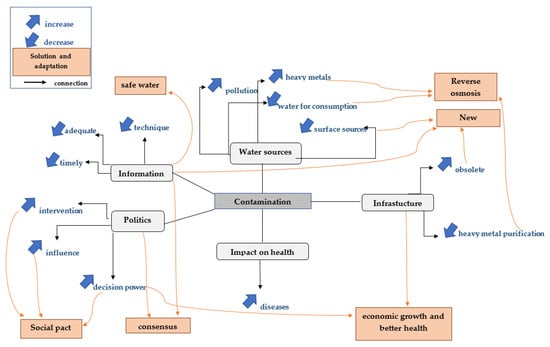
Figure 7.
Construction of the tree of assumptions for the effects of contamination.
Figure 7 shows how the main problem in the study area is the contamination of drinking water, which leads to the following conflict scenarios: obsolescence of infrastructure not suitable for the treatment of heavy metals, increase of diseases, decrease of drinking water, loss of surface sources, and influence of stakeholders on technical decisions. Finally, two social and political scenarios are observed due to the lack of information and political interventions in decision-making.
The solutions lie in the implementation of adequate systems for the treatment of toxic contaminants such as heavy metals, and in the generation of consensus and social pacts to guarantee new ventures in the sector. Strategies among stakeholders are needed.
3.2. Identification of Interest Groups
Following the criteria of Leach [65] and the proposal of Hearne and Torpen [20], interviews were conducted with the main leaders and directors of the groups that make up civil society in the municipality of Tarija, identifying the main interest groups through the diagram from Figure 8.
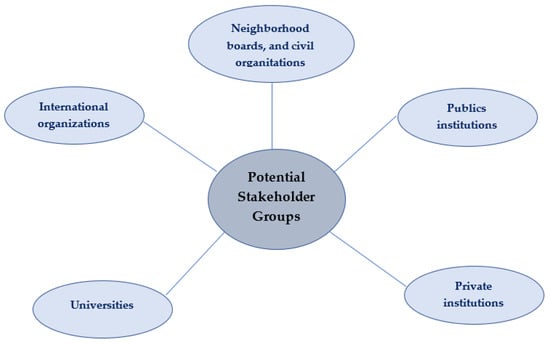
Figure 8.
Main interest and focus groups.
Figure 8 details the interest groups around the project, indicating the neighborhood councils that represent the neighborhoods; public institutions are characterized at the state, national, departmental, and local or municipal levels. At the same time, universities and private entities play a technical role in decision-making. International organizations are essential for the financing of projects.
3.3. Stakeholder Analysis
In this section, the identification, classification, and relationship between the stakeholders are detailed.
3.3.1. Identification
Identifying the focus and interest groups identifies the strategic stakeholders that are part of the political–administrative decision-making process of the department. For the identification, the current legal regulations were used, which indicate the administrative levels of the state. For other private, civic, and social representatives, interviews were conducted with central authorities or leaders identified through media or social networks. Table 2 details the identification of the different stakeholders.

Table 2.
Identification of interested parties.
Table 2 details the 23 actors identified among public and private, national, international, and local intervention institutions. Of the 23 actors, 52% are national and departmental government agencies, 8% are international, 22% are local and municipal, and 18% are social or civic, such as neighborhood councils and local communities with a robust legal system.
3.3.2. Categorization
From the data obtained in the interviews, the interested parties were organized by levels of intervention, from local to international, using the orbits [68]; Figure 9 shows this system.
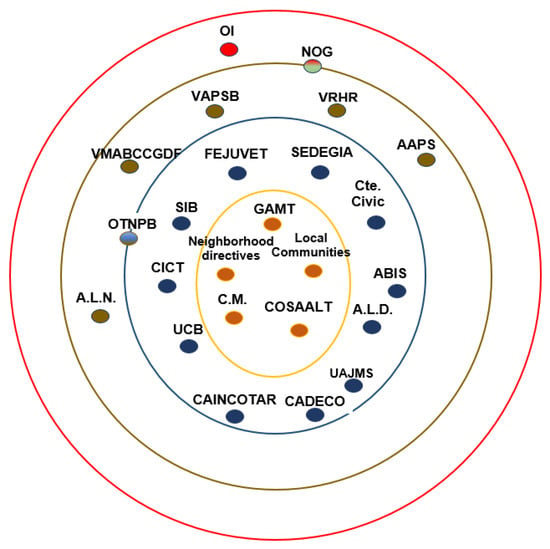
Figure 9.
Stakeholder categorization.
Figure 9 shows that there are five local, eleven departmental, five national, and one international level of intervention, mainly the IDB and the WB. While the municipality of Tarija is the most credible body at the local level, the departmental government and the Ministry of the Environment are at the departmental and national levels. The OTNPB is a national entity with exclusive intervention at the departmental level, similarly to NGOs, which are local entities but receive international funding.
3.3.3. Classification
Eight actors with a high degree of influence and different levels of interest were identified; FEJUVE and the Municipal Government of Tarija represented the actors with the greatest interest in the project; the Vice Ministries and the National, Departmental, and Local Legislative Assemblies showed relative interest.
On the other hand, the civic and private entities, although not influencing the decision-making process, showed certain degrees of interest in the project; professional associations, the civic committee, and personal entities, such as the chambers of commerce and construction, had the least influence, but showed a high commercial interest in the project. At a medium level were service companies such as COSAALT, the departmental secretariats such as SEDEGIA, and the NGOs, the OTNPB, and the local communities, which showed high interest in the project but had a moderate influence on it. Universities play a technical advisory role, whose participation is sporadic. Figure 10 shows the classification.
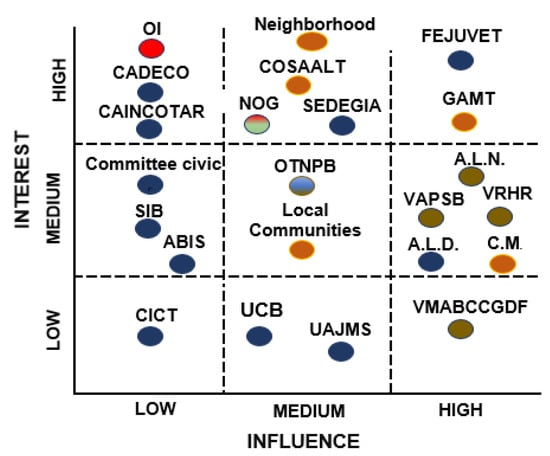
Figure 10.
Stakeholder identification and classification matrix by the level of interest and influence.
Figure 11 shows that in group A, a group of private and technical entities is concentrated with high interest in the project but little influence in the decision-making process. FEJUVE and the neighborhoods have the greatest interest in the generation of the project, but their power level is relatively low.
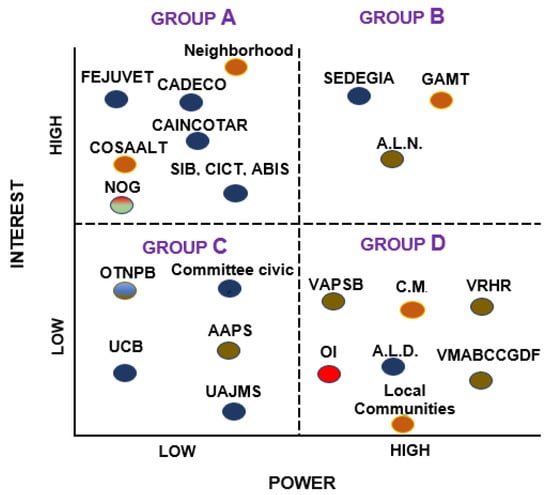
Figure 11.
Classification matrix by interest and power of stakeholders.
On the other hand, political institutions, such as the municipalities and governorates in group B, have the most important power and influence. Group C, which mainly consists of academic institutions, has the lowest level of interest and influence in water management.
Finally, group D includes actors whose interest is low but power is high, because this group mainly comprises regulatory bodies and legislative institutions.
Table 3 shows the classification of stakeholders based on attribute scales according to power, legitimacy, urgency, and proximity to the project.

Table 3.
Classification of stakeholders based on attributes and scales.
Table 3 shows three groups marked by the level of intervention in decisions. On the one hand, there are the executive and legislative bodies of the three levels of government, with definitive and collaborative participation in the project. On the other hand, there are local communities, albeit with significant participation; however, their intervention is only one of knowledge and not collaboration.
Another group at the national executive level, such as the deputy ministries of the environment and basic sanitation, have expected participation in the need for their intervention or knowledge. The service companies are the most interested in the implementation of the projects; they can only have expectant participation.
3.3.4. Relationship and Inter-Relation
This stage of the analysis is one of the most important because it visualizes the power groups and their influence on public management. The initial identification of the interested parties and the relationship generated between them was carried out through qualitative analysis.
For the qualitative analysis, interviews were mainly conducted with prominent leaders. Social networks, information from the media, and information from public institutions such as the government, COSALTT, and the municipality were also consulted.
The interviews were open and flexible; the interviewees answered in order and in the simplest way possible. The questions were focused on the specific problem of water in the study area, and the knowledge they might have about potabilization with RO. Interviewees talked about the contamination of water sources and the institutionality in the department.
Issues related to water management, responsible institutions, and economic resources allocated to this sector were analyzed.
Table 4 highlights the inter-relationship actions between interested parties, elaborating collaborative work strategies to achieve the best possible implementation of the project, avoiding social, political, and economic problems.

Table 4.
Interest, influence, and relationship between stakeholders.
In the first place, clear need for a relationship between the levels of departmental and local government with the national level is observed. Considering the competencies of each level of government and the availability of economic resources, a lack of coordination is maintained in the interventions in projects related to water resources.
At the departmental level, a complex focus group is identified: the Federation of Neighborhood Councils [FEJUVE], the neighborhoods, and water and sanitation cooperative. This is one of the most critical groups in water management; on the one hand, it is the responsibility of the neighborhood councils to supervise, promote, and facilitate the projects and programs of the sector; on the other hand, the cooperative needs investments to ensure profitability in the area concession.
Private entities such as the Chambers of Construction and Industry and the Associations of Engineers have a real commercial interest, which groups them with a correlation of interests.
It is important to point out that, according to the Bolivian Constitution, any project must undergo a consultation process with the local communities where the water sources are located, so that the departmental and municipal public bodies must be linked and related to these local bodies.
Finally, the legislative bodies have significant political weight, so any executive body must have a direct relationship with parliamentarians and legislators to manage and process regulations regarding the project.
3.3.5. Stakeholder Effects
Figure 12 shows the level of involvement of the different stakeholders according to the degree of influence they have in decision-making concerning the project.
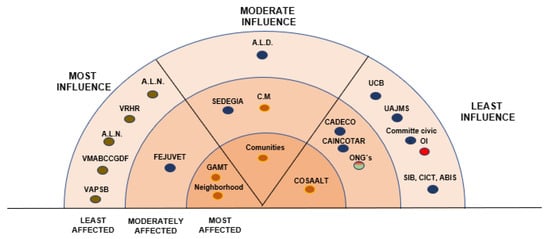
Figure 12.
Effect diagram.
Figure 12 depicts the effects from the political, social, and economic aspects; at the same time, national institutions of the executive and legislative levels have a high degree of influence on the decisions, but the level of effect is minor if the project does not materialize. On the other hand, it can be seen that local institutions such as neighborhoods, communities, the municipality, or the operating company are the most affected. This is explained by the lack of an adequate treatment project; the direct consequence affects the neighborhoods and the people.
At the departmental level, private entities may have little influence but a high or moderate impact because the projects generate economic growth. In another area are the universities or collegiate institutions, whose impact and influence are low.
3.4. Social Network Analysis
First, the attributes of each stakeholder were defined in create social networks to analyze the degree of communication and interconnectivity among stakeholders. They were assigned distinctive colors to identify the detailed stakeholders in the social network. Figure 13 illustrates the web of interactions and connectivity among the various stakeholders.
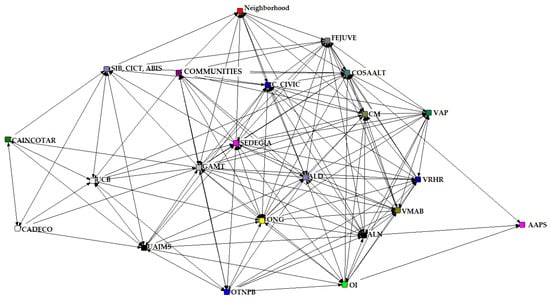
Figure 13.
Stakeholder social network.
The ARS shows the results on the most interconnected actors and those of intermediation. The 13 actors with the best degree of output centrality are: ALD, SEDEGIA, NOG, GAMT, CM, C. CIVIC, COSAALT, FEJUVE, Communities, VAP, ALN, VRHR, and VMAB, actors which are recipients of information with the other interested parties intending to establish links with them.
The actors with the highest intermediation centrality are SEDEGIA, ALD, NOG, and GAMT. The network also shows the existing polarization in the media, either due to political factors or the role of each party in society. However, the most significant interaction occurs between the departmental political level, the GMT, and FEJUVE; the neighborhoods and COSAALT exchange the most information. The history of public administration shows the greatest homophily [76]. The private sector has little interconnectivity with the public sector, but greater interconnectivity among its counterparts.
The statistical results show that the density of the network is 0.872, i.e., 87% of the interested parties have some kind of relationship or link with the rest. Those with the most extraordinary centrality and power in the network are the GM, SEDEGIA, and FEJUVE, and social organizations such as local communities and neighborhoods.
Those with the highest relationship degrees are the OI, GM, SEDEGIA, and FEJUVE, followed by another group of essential actors such as the communities and COSAALT, the legislative assemblies and vice ministries, universities, and collegiate institutions. Similarly, to SIB, they show a significant relationship. However, private institutions have the lowest level of connection.
3.5. Vulnerable Areas in the Study Area
The application of RO in vulnerable rural areas of the municipality of Tarija is a future alternative in the short term. The contamination process affecting the basin shows the high environmental vulnerability of its water resources, and an adequate governance process will enable adequate implementation of this new technology.
3.6. Discussion
As pointed out by Gagliardo et al., Hearne et al., Palé et al., and Ogada et al. [19,20,21,22], information asymmetries and conflicts of interest are observed in water management in the municipality of Tarija, because there are different interests and influences of actors, motivated by political aspects in many cases.
There is clear identification, classification, and differentiation of the interested actors according to their political, social, and economic participation, as proposed by Red et al., [47]. In addition, as proposed by Yang et al. and Trawick [48,49], based on the above, it has been possible to identify the degree of interest, power, influence, and decision that each stakeholder has in the implementation of the project.
The influence on stakeholders is generated based on the interest and participation of the stakeholders, which agrees with what was posited by Lupo and the ODA [50,51].
Stakeholder concentrations of power and decision-making, identified in the analysis of social networks and the main links with other actors, are visualized, a result which agrees with what has been suggested by León and Hirschia [57,59].
4. Conclusions
The contamination of drinking water is the main water resource problem affecting rural areas in the municipality of Tarija. Conflict scenarios were identified referring to: obsolete and inadequate infrastructure for the treatment of heavy metals; increase in diseases; decrease in drinking water; loss of surface sources; and influence of stakeholders in technical decisions.
In the political and social sphere, two scenarios were identified: lack of information and political interference in decision-making.
A study was conducted on the implementation of reverse osmosis for the treatment of water with toxic contaminants in Tarija. The results show that RO has a high efficiency and effectiveness in purification, operating at low pressures, showing significant efficiency from the point of view of energy saving. The main actors are not aware of this technology, and others point out that it is an expensive system; this confirms that the implementation of this system requires further analysis of the interested parties to guarantee its operability and sustainable operation.
Twenty-three stakeholders have been identified, including public, private, civic/social, and professional institutions. The analysis and the nature of each of them have enabled them to be grouped according to the interest, influence, and power they can exercise around the management and execution of the project.
Executive bodies such as Vice Ministries, governorships, and municipalities are in charge and directly responsible for managing a project, and legislative bodies at different levels of government play a fundamental political and legislative role in its realization, making it necessary for both powers of the state to foster a definitive and collaborative relationship.
Intermediate public and personal levels with high interest and influence in the project were identified, and the neighborhood councils and the service providers generated a natural link due to the excellent execution of the project.
A group of interested parties of a purely private nature, with real commercial interests, will have meaningful participation in the execution of the project, which must be taken into account during negotiations.
International organizations and NGOs play technical and economic roles in the management of the project, essentially in the technical decisions that are made around the project.
Multilateral organizations, such as the World Bank or the IDB, have standards for project design, bidding, and execution that must be met for project financing.
Neighborhoods, through their legally established authorities, have decisive participation in the definition of the projects; the decision to execute a project or locate a particular work in a neighborhood or urban area requires their approval and acceptance, for which the link and relationship with these institutions must be continuous and definitive, correctly and promptly informing the technical decisions that are made in the project.
The local institutions that represent ordinary citizens are the most affected by the lack of agreements and consensus to implement an adequate project that guarantees safe water to the city of Tarija.
The social network confirms political polarization in the study area; although it shows an average density of ties in the network, few institutions focus on power and information.
The political differences and the constant changes in local and departmental governments generate conflict scenarios that make it difficult to reach consensuses in meetings with all the stakeholders interested in the projects. The interviews were conducted independently and separately from the prominent social and political leaders.
Once the parties interested in the generation of projects and the different interests that each one have been identified, the next step is to organize a water meeting and seek consensus so that this and other similar projects can be implemented in the shortest possible time, guaranteeing safe water for the population.
Author Contributions
Conceptualization, Methodology, Software, Validation, Formal analysis, Investigation, Resources, Data curation, Writing—Original draft, Visualization, E.M.V.-M.; Conceptualization, Methodology, Investigation, Writing—Review and Editing, P.A.A.-T.; Writing—Review and Editing, Visualization, Supervision, V.G.L.-I.-F.; Validation, Formal analysis, Data curation, J.L.-G.; Supervision, Project administration, J.I.T.-L.; Project administration, L.S.B., A.L.F. and P.d. All authors have read and agreed to the published version of the manuscript.
Funding
This study was supported by Subproject 2 of the Agreement for the Implementation of Phase 2 of the Institutional Cooperation Project VLIR UOS IUC-Universidad Católica Boliviana San Pablo between 1 September 2022 and 31 August 2027.
Data Availability Statement
Not applicable.
Acknowledgments
The authors appreciate the support of the national and regional authorities of the Universidad Católica Boliviana “San Pablo”. The research has been carried out with the support of the Center for Research in Engineering and Exact Sciences of the Department of Basic Sciences and Infrastructure (CIICE) of the Universidad Católica Boliviana Sede Tarija, and the Center for Research in Water, Energy and Sustainability (CINAES) of the career of Environmental Engineering of the Bolivian Catholic University “San Pablo” La Paz headquarters. We thank Subproject 2 “Contribution to integrated water management in Bolivia” of the CReA project for the support and financing of this publication.
Conflicts of Interest
The authors declare that they have no known competing financial interest or personal relationships that could have appeared to influence the work reported in this paper.
References
- Chen, L.; Zhang, X.; Cao, M.; Pan, Y.; Xiao, C.; Wang, P.; Liang, Y.; Liu, G.; Cai, Y. Release of legacy mercury and effect of aquaculture on mercury biogeochemical cycling in highly polluted Ya-Er Lake, China. Chemosphere 2021, 275, e130011. [Google Scholar] [CrossRef] [PubMed]
- Mora, A.; García-Gamboa, M.; Sánchez-Luna, M.S.; Gloria-García, L.; Cervantes-Avilés, P.; Mahlknecht, J. A review of the current environmental status and human health implications of one of the most polluted rivers of Mexico: The Atoyac River, Puebla. Sci. Total Environ. 2021, 782, e146788. [Google Scholar] [CrossRef] [PubMed]
- Runkel, A.A.; Križanec, B.; Lipičar, E.; Baskar, M.; Hrženjak, V.; Kodba, Z.C.; Kononenko, L.; Kanduč, T.; Mazej, D.; Tratnik, J.S.; et al. Organohalogens: A persisting burden in Slovenia? Environ. Res. 2021, 198, e111224. [Google Scholar] [CrossRef]
- Garrido, A.E.; Strosnider, W.H.; Wilson, R.T.; Condori, J.; Nairn, R.W. Metal-contaminated potato crops and potential human health risk in Bolivian mining highlands. Environ. Geochem. Health 2017, 39, 681–700. [Google Scholar] [CrossRef]
- Quaghebeur, W.; Mulhern, R.E.; Ronsse, S.; Heylen, S.; Blommaert, H.; Potemans, S.; Valdivia Mendizábal, C.; Terrazas García, J. Arsenic contamination in rainwater harvesting tanks around Lake Poopó in Oruro, Bolivia: An unrecognized health risk. Sci. Total Environ. 2019, 688, 224–230. [Google Scholar] [CrossRef] [PubMed]
- Salvarredy-Aranguren, M.M.; Probst, A.; Roulet, M.; Isaure, M.-P. Contamination of surface waters by mining wastes in the Milluni Valley (Cordillera Real, Bolivia). Mineralogical and hydrological influences. Appl. Geochem. 2008, 23, 1299–1324.e5. [Google Scholar] [CrossRef]
- Alvizuri, P.A.; Torregrosa, J.I.; Lo Iacono, V.G.; Salinas, O.R. Heavy metals problem in micro-basin that feeds a drinking water dam, Milluni—Bolivia case. In Proceedings of the XXIII International Congress on Project Management and Engineering, Málaga, Spain, 10–12 July 2019; pp. 1059–1071. Available online: http://dspace.aeipro.com/xmlui/handle/123456789/2396 (accessed on 13 June 2023).
- Villena, E.; Alvizuri, P.; Lo Iacono, V.; Torregrosa, J.; Lora, J. Reverse Osmosis Pilot Plant to Removal Heavy Metals Pb, Fe, As, Zn and Mn in Consumption Waters in Bolivia. In Proceedings of the 24th International Congress on Project Management and Engineering, Alcoy, Spain, 7–9 July 2020; pp. 1252–1264. Available online: http://dspace.aeipro.com/xmlui/handle/123456789/2509 (accessed on 13 June 2023).
- Zak, S. Treatment of the processing wastewaters containing heavy metals with the method based on flotation. Ecol. Chem. Eng. S 2012, 19, 433–438. [Google Scholar] [CrossRef][Green Version]
- Abdullah, N.; Yusof, N.; Lau, W.J.; Jaafar, J.; Ismail, A.F. Recent trends of heavy metal removal from water/wastewater by membrane technologies. J. Ind. Eng. Chem. 2019, 76, 17–38. [Google Scholar] [CrossRef]
- Razzak, S.; Faruque, M.; Alsheikh, Z.; Alsheikhmohamad, L.; Alkuroud, D.; Alfayez, A.; Hossain, S.M.; Hossain, M. A comprehensive review on conventional and biological-driven heavy metals removal from industrial wastewater. Environ. Adv. 2022, 7, 100168. [Google Scholar] [CrossRef]
- Borji, H.; Ayoub, G.M.; Bilbeisi, R.; Nassar, N.; Malaeb, L. How Effective Are Nanomaterials for the Removal of Heavy Metals from Water and Wastewater? Water Air Soil Pollut. 2020, 231, 330. [Google Scholar] [CrossRef]
- Walschot, M.; Luis, P.; Liégeois, M. The challenges of reverse osmosis desalination: Solutions in Jordan. Water Int. 2020, 45, 112–124. [Google Scholar] [CrossRef]
- Sahin, O.; Stewart, R.; Porter, M. Water security through scarcity pricing and reverse osmosis: A system dynamics approach. J. Clean. Prod. 2015, 88, 160–171. [Google Scholar] [CrossRef]
- Cervantes-Rendón, E.; Ibarra-Bahena, J.; Cervera-Gómez, L.E.; Romero, R.J.; Cerezo, J.; Rodríguez-Martínez, A.; Dehesa-Carrasco, U. Rural Application of a Low-Pressure Reverse Osmosis Desalination System Powered by Solar–Photovoltaic Energy for Mexican Arid Zones. Sustainability 2022, 14, 10958. [Google Scholar] [CrossRef]
- Villena-Martínez, E.M.; Alvizuri-Tintaya, P.A.; Lora-García, J.; Torregrosa-López, J.I.; Lo-Iacono-Ferreira, V.G. Reverse Osmosis Modeling Study of Lead and Arsenic Removal from Drinking Water in Tarija and La Paz, Bolivia. Processes 2022, 10, 1889. [Google Scholar] [CrossRef]
- Villena-Martínez, E.M.; Alvizuri-Tintaya, P.A.; Torregrosa-López, J.I.; Lo-Iacono-Ferreira, V.G.; Lora-García, J. The role of stakeholders in water management in the guadalquivir and milluni basins in bolivia. In Proceedings of the XXV International Congress on Project Management and Engineering, Alcoy, Spain, 6–9 July 2021; pp. 1215–1229. [Google Scholar]
- Alvizuri-Tintaya, P.A.; Villena-Martínez, E.M.; Avendaño-Acosta, N.; Lo-Iacono-Ferreira, V.G.; Torregrosa-López, J.I.; Lora-García, J. Contamination of Water Supply Sources by Heavy Metals: The Price of Development in Bolivia, a Latin American Reality. Water 2022, 14, 3470. [Google Scholar] [CrossRef]
- Gagliardo, P.; Adham, S.; Trussell, R.; Olivieri, A. Water repurification via reverse osmosis. Desalation 1998, 117, 73–78. [Google Scholar] [CrossRef]
- Hearne, R.R.; Torpen, R.D. Stakeholder preferences for water management alternatives in the Red River Basin. Water Int. 2010, 35, 150–164. [Google Scholar] [CrossRef]
- Palé, S.; Wellens, J.; Traoré, F.; Roncoli, C.; Mohamed-Sallah, A.; Zangré, A.; Tychon, B. Testing an open app-based water management information system and its uptake among stakeholders in the Upper-Comoé river basin (Burkina Faso). Water Int. 2021, 46, 417–431. [Google Scholar] [CrossRef]
- Ogada, J.; Krhoda, G.; Van Der Veen, A.; Marani, M.; Richards van Oel, P. Managing resources through stakeholder networks: Collaborative water governance for Lake Naivasha basin, Kenya. Water Int. 2017, 42, 271–290. [Google Scholar] [CrossRef]
- Trubetskaya, A.; Horan, W.; Conheady, P.; Stockil, K.; Moore, S. A Methodology for Industrial Water Footprint Assessment Using Energy-Water-Carbon Nexus. Processes 2021, 9, 393. [Google Scholar] [CrossRef]
- Beisheim, M. The Water, Energy & Food Security Nexus: How to Govern Complex Risks to Sustainable Supply; SWP-Studie 11/2013; Stiftung Wissenschaft und Politik: Berlin, Germany, 2013; Available online: https://www.econstor.eu/bitstream/10419/256260/1/2013C32.pdf (accessed on 10 July 2023).
- Lemos, M.C.; Kirchhoff, C. Climate Information and Water Management. In The Oxford Handbook of Water Politics and Policy; Conca, K., Weinthal, E., Eds.; Oxford University Press: Oxford, UK, 2016; Volume 1, Available online: https://scholar.google.com/scholar?hl=es&as_sdt=0%2C5&q=Lemos%2C+M.C.%3B+Kirchhoff%2C+C.+Climate+Information+and+Water+Management.+In+The+Oxford+Handbook+of+Water+Politics+and+Policy%3B+Conca%2C+K.%2C+Weinthal%2C+E.%2C+Eds.%3B+Oxford+University+Press%3A+Oxford%2C+UK%2C+Volume+1.+2016&btnG= (accessed on 13 June 2023).
- Lima-Quispe, N.; Coleoni, C.; Rincón, W.; Gutierrez, Z.; Zubieta, F.; Nuñez, S.; Iriarte, J.; Saldías, C.; Purkey, D.; Escobar, M.; et al. Delving into the Divisive Waters of River Basin Planning in Bolivia: A Case Study in the Cochabamba Valley. Water 2021, 13, 190. [Google Scholar] [CrossRef]
- Fratini, C.F.; Geldof, G.D.; Kluck, J.; Mikkelsen, P.S. Three Points Approach (3PA) for Urban Flood Risk Management: A Tool to Support Climate Change Adaptation through Transdisciplinarity and Multifunctionality. Urban Water J. 2012, 9, 317–331. [Google Scholar] [CrossRef]
- Stahre, P. Sustainability in Urban Storm Drainage; Svenskt Vatten: Bromma, Sweden, 2006. [Google Scholar]
- Arnbjerg-Nielsen, K. Quantification of Climate Change Effects on Extreme Precipitation Used for High Resolution Hydrologic Design. Urban Water J. 2012, 9, 57–65. [Google Scholar] [CrossRef]
- Larsen, T.A.; Gujer, W. The Concept of Sustainable Urban Water Management. Water Sci. Technol. 1997, 35, 3–10. [Google Scholar] [CrossRef]
- Kaspersen, P.S.; Ravn, N.H.; Arnbjerg-Nielsen, K.; Madsen, H.; Drews, M. Comparison of the Impacts of Urban Development and Climate Change on Exposing European Cities to Pluvial Flooding. Hydrol. Earth Syst. Sci. 2017, 21, 4131–4147. [Google Scholar] [CrossRef]
- Skrydstrup, J.; Madsen, H.; Löwe, R.; Bülow Gregersen, I.; Nedergaard Pedersen, A.; Arnbjerg-Nielsen, K. Incorporating objectives of stakeholders in strategic planning of urban water management. Urban Water J. 2020, 17, 87–99. [Google Scholar] [CrossRef]
- Edelenbos, J.; van Schie, N.; Gerrits, L. Organizing interfaces between government institutions and interactive governance. Policy Sci. 2010, 43, 73–94. [Google Scholar] [CrossRef]
- Rinaudo, J.; Garin, P. The benefits of combining lay and expert input for water-management planning at the watershed level. Water Policy 2005, 7, 279–293. [Google Scholar] [CrossRef]
- Petts, J.; Brooks, C. Expert conceptualizations of the role of lay knowledge in environmental decisionmaking: Challenges for eliberative democracy. Environ. Plan. A 2006, 38, 1045–1059. [Google Scholar] [CrossRef]
- Lintsen, H. Two Centuries of Central Water Management in the Netherlands. Technol. Cult. 2002, 43, 549–568. [Google Scholar] [CrossRef]
- McClean, S.; Shaw, A. From schism to continuum? The problematic relationship between expert and lay knowledge: An exploratory conceptual synthesis of two qualitative studies. Qual. Health Res. 2005, 15, 729–749. [Google Scholar] [CrossRef] [PubMed]
- Van Buuren, A. Knowledge for governance, governance of knowledge. Inclusive knowledge management in collaborative governance processes. Int. Public Manag. J. 2009, 12, 208–235. [Google Scholar] [CrossRef]
- Ponok, N.; Arunrat, N.; Pumijumnong, N.; Hamasaki, H.; Sereenonchai, S. Challenges of Water Policy Involvement of the Community in the East Coast River Basin of Thailand. Water 2021, 13, 3395. [Google Scholar] [CrossRef]
- Ponok, N.; Arunrat, N.; Pumijumnong, N.; Hamasaki, H.; Stewart, T.; Sereenonchai, S. Developing a tool for community involvement in water policy decision-making using strategic environmental assessments and serious games. Community Dev. J. 2022, 13, 3395. [Google Scholar] [CrossRef]
- Roger, P.; Hall, A. Effective Water Governance. Glob. Water Partnersh. Tech. Comm. 2003, 7, 4–48. [Google Scholar]
- Water Governance Facility. Programa de las Naciones Unidas 2011. Available online: https://www.watergovernance.org/water-governance/ (accessed on 10 July 2023).
- Dourojeanni, A.; Jouravlev, A. Crisis de gobernabilidad en la gestión del agua. In Recursos Naturales e Infraestructura-CEPAL; Naciones Unidas: Santiago, Chile, 2001. [Google Scholar]
- Freeman, E.R. Strategic Management: A Stakeholder Approach; Pitman Publishing, Inc.: Boston, MA, USA, 1984. [Google Scholar]
- Jacobs, M.H.; Buijs, A.E. Understanding stakeholders’ attitudes toward water management interventions: Role of place meanings. Water Resour. Res. 2011, 47, W01503. [Google Scholar] [CrossRef]
- Mayers, J. Análisis del poder de las partes interesadas. Int. Inst. Environ. Dev. 2005. Available online: https://policy-powertools.org/Tools/Understanding/docs/stakeholder_power_tool_spanish.pdf (accessed on 10 July 2023).
- Reed, M.; Graves, A.; Dandy, N.; Póstumo, H.; Hubacek, K.; Morris, J.; Prelle, C.; Quienn, C.; Stringerb, L. Who’s in and why? A typology of stakeholder analysis methods for natural resource management. J. Environ. Manag. 2009, 90, 1933–1949. [Google Scholar] [CrossRef]
- Yang, L.; Shun-Chan, F.; Scheffran, Y. Climate change, water management, and stakeholder analysis in the Dongjiang River basin in South China. Int. J. Water Resour. Dev. 2016, 34, 166–191. [Google Scholar] [CrossRef]
- Trawick, P. Against the privatization of water: An indigenous model for improving existing laws and successfully governing the commons. World Dev. 2003, 31, 977–996. [Google Scholar] [CrossRef]
- Lupo, P. Stakeholder involvement in water management: The role of the stakeholder analysis within participatory processes. Water Policy 2010, 12, 675–694. [Google Scholar]
- Overseas Development Administration. Guidance Note on How to Do Stakeholder Analysis of Aid Projects and Programmes 1995. Available online: www.euforic.org/gb/stake1.htm (accessed on 6 June 2023).
- Clarkson, M.; Starik, M.; Cochran, P.; Jones, T.M. The Toronto conference: Reflections on stakeholder theory. Bus. Soc. 1994, 33, 82–131. [Google Scholar] [CrossRef]
- Grimble, R.; Wellard, K. Stakeholder methodologies in natural resource management: A review of principles, context, experiences and opportunities. Agric. Syst. 1997, 55, 173–193. [Google Scholar] [CrossRef]
- Mitchell, R.K.; Agle, B.R.; Wood, D.J. Toward a theory of stakeholder identification and salience: The principle of who and what really counts. Acad. Manag. Rev. 1997, 22, 853–886. [Google Scholar] [CrossRef]
- European Commission [EC]. Common Implementation Strategy for the Water framework Directive (2000/60/CE)—Guidance Document 2003. Available online: http://www.europa.eu.int/comm/environment/water/water-framework/index_en.html (accessed on 6 June 2023).
- Baccar, M.; Bergez, J.-E.; Couture, S.; Sekhar, M.; Ruiz, L.; Leenhardt, D. Building Climate Change Adaptation Scenarios with Stakeholders for Water Management: A Hybrid Approach Adapted to the South Indian Water Crisis. Sustainability 2021, 13, 8459. [Google Scholar] [CrossRef]
- León, C. Planteamiento de un Proceso Participativo Para la Propuesta y Priorización de Proyectos de Desarrollo Regional. Caso de Estudio Departamento del Meta en Colombia. Ph.D. Thesis, Universitat Politècnica de València, Valencia, Spain, September 2021. [Google Scholar]
- Ramírez, J. La participación ciudadana en la democracia. In Psychology Applied to Work: An Introduction to Industrial and Organizational Psychology, 10th ed.; Instituto Electoral y de Participación Ciudadana de Jalisco: Jalisco, México, 2013. [Google Scholar] [CrossRef]
- Hirschia, C. Introduction: Applications of social network analysis. Procedia Soc. Behav. Sci. 2010, 4, 2–3. [Google Scholar] [CrossRef][Green Version]
- Ministerio de Medio Ambiente y Agua. Plan Nacional de Cuencas Balance Hídrico Superficial de la Cuenca del Guadalquivir. La Paz 2015. Available online: https://www.bivica.org/files/balance-hidrico_Bolivia.pdf (accessed on 6 June 2023).
- Gobernación del Departamento de Tarija. Plan Departamental del Agua, Tarija-Bolivia 2013. Available online: https://sihita.org/wp-content/uploads/2022/01/DOC092.pdf (accessed on 6 June 2023).
- Alba, R.; Rivera, R. Organizational analysis of the entrepreneurs of the Sub Central Cirminuelas and its potential to take advantage of the tarijeño entrepreneurs ecosystem offer card, case: APAT. Rev. Perspect. 2020, 46, 81–102. Available online: http://www.scielo.org.bo/scielo.php?pid=S1994-37332020000200004&script=sci_abstract&tlng=en (accessed on 6 June 2023).
- Mendoza, L.; Olarte, K.; Rivera, R. Reflective practice as a methodology of identification of a micro-region from the criteria of vulnerability and potentiality: The case of Subcentral Cirminuelas. J. Comun. Soc. 2021, 12, 81–114. Available online: https://jcomsoc.ucb.edu.bo/a/article/view/1241 (accessed on 6 June 2023).
- Shi, Q.; Liu, Y.; Zuo, J.; Pan, N.; Ma, G. On the management of social risks of hydraulic infrastructure projects in China: A case study. Int. J. Proj. Manag. 2015, 33, 483–496. [Google Scholar] [CrossRef]
- Leach, W.D. Surveying Diverse Stakeholder Groups. Soc. Nat. Resour. 2002, 15, 641–649. [Google Scholar] [CrossRef]
- Aggens, L. Identifying different levels of public interest in participation. In Public Involvement Techniques: A Reader of Ten Years Experience at the Institute for Water Resources; Creighton, J.L., Delli Priscoli, J., Dunning, C.M., Eds.; IWR Research Report 82_R-1; IWR-USACE: Alexandria, VA, USA, 1998. [Google Scholar]
- Biggs, S.; Matsaert, H. An actor-orientated approach for strengthening research and development capabilities in natural resource systems. Public Adm. Dev. 1999, 19, 231–262. [Google Scholar] [CrossRef]
- Chevalier, J.M.; Buckles, D.J. SAS2: A Guide to Collaborative Inquiry and Social Engagement; Sage Publications: New Delhi, India, 2008; Available online: https://methods.sagepub.com/book/sas2-social-analysis-systems (accessed on 6 June 2023).
- Clarke, T.; Clegg, S. Changing Paradigms: The Transformation of Management Knowledge for the 21st Century; Harper Collins: London, UK, 1998. [Google Scholar]
- Villena, E.; Alvizuri, P.; Lo Iacono, V.; Torregrosa, J.; Lora, J. El Rol De Las Partes Interesadas En La Gestion Del Agua En Las Cuencas Del Guadalquivir Y Milluni En Bolivia. In Proceedings of the 25th International Congress on Project Management and Engineering, Alcoy, Spain, 7–9 July 2021; pp. 1215–1229. [Google Scholar]
- Coplin, W.D.; McMaster, D.J.; O’Learly, M.K. Creating policy profile. In Public Involvement Techniques: A Reader of Ten Years Experience at the Institute for Water Resources; Creighton, J.L., Delli Priscoli, J., Dunning, C.M., Eds.; IWR Research Report 82_R-1; IWR-USACE: Alexandria, VA, USA, 1998. [Google Scholar]
- Lupo, S.; Collentine, D. Stakeholder discourse and water management—Implementation of the participatory model CATCH in a Northern Italian alpine sub-catchment. Hydrol. Earth Syst. Sci. 2008, 12, 317–331. [Google Scholar] [CrossRef]
- Overseas Development Administration. Note on Enhancing Stakeholder Participation in Aid Activities. 1995. Available online: www.euforic.org/gb/stake2.htm (accessed on 20 June 2023).
- Prell, C.; Hubacek, K.; Reed, M. Stakeholder Analysis and Social Network Analysis in Natural Resource Management. Soc. Nat. Resour. 2009, 22, 501–518. [Google Scholar] [CrossRef]
- Borgatti, S.P.; Everett, M.G.; Johnson, J.C. Analyzing Social Networks; SAGE: Thousand Oaks, CA, USA, 2022; Volume 3, 296p, Available online: https://us.sagepub.com/en-us/nam/analyzing-social-networks-using-r/book271675 (accessed on 20 June 2023).
- Ma, L.; Krishnan, R.; Montgomery, A.L. Latent homophily or social influence? an empirical analysis of purchase within a social network. Manag. Sci. 2015, 61, 454–473. [Google Scholar] [CrossRef]
Disclaimer/Publisher’s Note: The statements, opinions and data contained in all publications are solely those of the individual author(s) and contributor(s) and not of MDPI and/or the editor(s). MDPI and/or the editor(s) disclaim responsibility for any injury to people or property resulting from any ideas, methods, instructions or products referred to in the content. |
© 2023 by the authors. Licensee MDPI, Basel, Switzerland. This article is an open access article distributed under the terms and conditions of the Creative Commons Attribution (CC BY) license (https://creativecommons.org/licenses/by/4.0/).